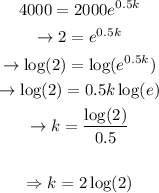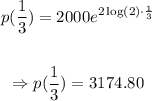Now, we know that the culture initially contains 2000 bacteria and that it doubles every half hour. Assuming that the time t is in hours, this would mean that

Solving for k,

This way, we would have that:

A)
20 minutes is 1/3 of an hour. This way,

Thereby, the bacterial population after 20 minutes is 3,174.80
B)

Thereby, the bacterial population after 6 hours is 8,192,000